Preparing 3D Models
Repair and optimize files to really get what you want.
Latest News
April 1, 2012
By Pamela J. Waterman
Part of the process of learning a new computer language involves the steps where a) the program crashes or b) it does exactly what you told it to do, but not what you wanted it to do. The same holds true for any 3D CAD file you create as the “program” to drive a 3D-printing/additive manufacturing (AM) system. If the information supplied in the original file isn’t the best it can be, the AM equipment will either reject the STL version of the part entirely, or build something that’s exactly what you defined—but definitely not what you wanted.
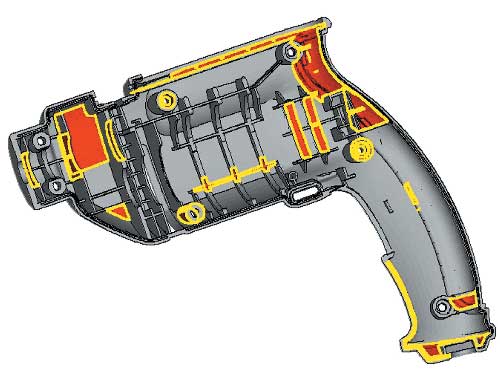
3D model of a power hand-drill housing containing CAD errors. Images courtesy Materialise.
How can you improve the chances of getting parts just right, or even better than expected? Go beyond the tools and wizards in your CAD software package, and check out the range of specialized software that helps you prepare 3D models for optimum production.
Starting with STL Files
AMF: Replacing STL for 3D Files? For all the amazing work that has been produced with design files in the STL format, there’s room for improvement. A basic issue is that this de-facto standard format only describes surface mesh geometry and has no way to include any information about materials. Ditto for color, texture, labeling, build orientation and more. Enter additive manufacturing file (AMF), an XML-based open standard interchange format proposed as the replacement for STL, initially released by ASTM International Subcommittee F42.04, May 2, 2011, as ASTM F2915-11. As of December 2011, several companies have announced AMF support, including Materialise, netfabb and Sculpteo. Wikipedia has an extensive write-up on the topic that is well-worth reading |
With virtually every CAD design package, you can save the native file of a 3D model in the STL format, the current standard for AM. The software does so by “wrapping” a triangulated mesh surface around the solid CAD model. However, each software package does it a little bit differently.
For example, one source of variation is the maximum separation of any triangle surface from the true part surface. (For a description of this conversion, see “The Making of an STL File” on page 42.) Other problems with the conversion come because the original file may have surfaces that overlap (indeterminate edges) or don’t quite meet (sliver gaps). Or, the data may have originally come from an imported 3D scan with noisy, inaccurate data.
To ensure that the AM system is working from a high-quality STL file, you may have to perform the following intermediary tasks, either manually or automatically:
- Close gaps and holes, which can be tricky on organic surfaces.
- Edit geometry, and verify that normal vectors point outward.
- Smooth surfaces, and avoid “ugly” surfaces.
- Cut/trim/extract features. This is a must for fitting into and working with certain AM machines.
- Reduce triangle count, as unnecessarily large files require long build times.
Beyond these steps, advanced users and service bureau providers may want to modify design elements to improve durability, modify the file for optimized material cost and weight, and set up batch production.
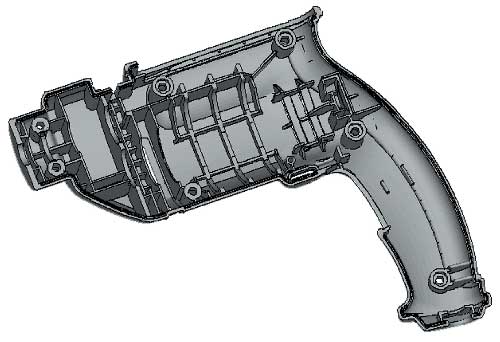
Power hand drill file after errors have been repaired with Materialise Magics16 software.
Fortunately, several companies have tackled various angles of these tasks. Materialise is a longtime player in this field, having started out as a one-machine rapid prototyping service bureau in 1990 and releasing the first version of Magics rapid prototyping software for the professional user in 1992; it is now marketing Magics 16.
netfabb and Within Lab offer more recent software solutions with a range of capabilities in this field, while some features of Geomagic software can also be relevant for file preparation. In addition, new web-based packages and printing services offer basic advice and online repair tools oriented to the growing direct-consumer market.
Repair Work Almost Like Magic
Materialise is a Belgian/US company that plays an outstanding role in many aspects of the international AM industry, addressing challenges in the medical, dental and technical fields. With hundreds of software developers on staff, it has deep experience in preparing and improving 3D files for any type of AM production.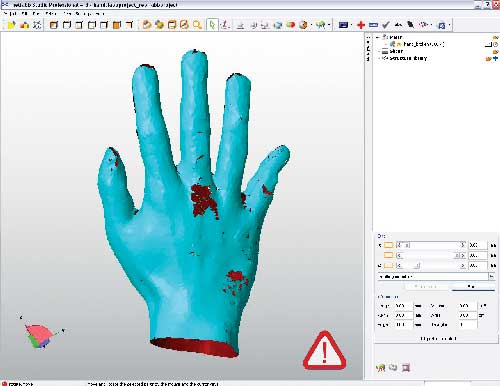
Original 3D CAD file of a scanned hand.
Magics 16 is targeted to the professional immersed in rapid prototyping and manufacturing (RP&M). The software is designed to streamline, automate and boost almost every step of the process—from file import to file repair, editing and enhancement, to setting up the actual build platform. The standard package supports importing dozens of neutral design file formats, including Google Sketchup 8.0 and the new AMF format (see “AMF: Replacing STL for 3D Files?” below), while add-ons let you choose direct support for CAD-oriented formats such as SolidWorks, CATIA, IGES, ACIS and STEP.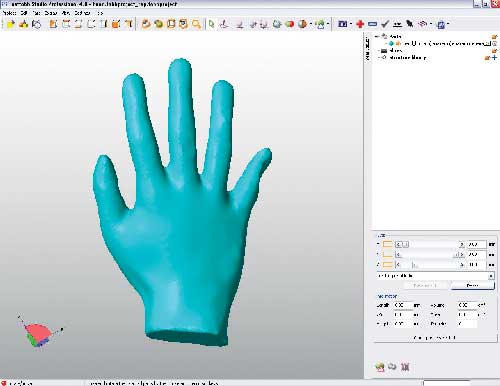
Scanned hand 3D CAD file repaired using netfabb Studio 4.8 3D-file repair and enhancement software. Images courtesy netfabb.
The power of Magics has been impressive from the beginning, helping users do in minutes what might have taken hours in a CAD package. For example, Brad Palumbo, senior manufacturing engineer at Phoenix Analysis & Design Technologies (PADT), has been using Magics for almost three years. He says that the software is invaluable in saving time for setting up optimized support structures for SLA part production. Palumbo also notes that it is easier to fix files and cut parts so they will fit into a particular machine’s build volume.
File Prep Options for a Wider Audience
The Making of an STL File Stereolithography.Com was the first online supplier of stereolithography services, developing a user interface that allowed remote file uploads, quotes, support and production. Based in Atlanta, the company has fulfillment partners around the country for fast part production and shipment, and has been using 3D Systems stereolithography machines since 1994. Here is the company’s perspective on STL file creation, adapted from its website, Stereolithography.com. “Generating STL files is usually a fairly simple process. Virtually all modern CAD systems now include STL output as a standard feature and, for the most part, the files created are suitable for rapid prototyping. But the extra step of converting CAD models into STL format still presents a barrier to rapid prototyping novices or occasional users. Imagine how annoying it would be if you had to select parameters and convert word-processing documents or spreadsheets into a special file format before you could print them. “Making STL files is further complicated by the fact that every CAD system uses different terms and parameters for defining the STL file’s resolution, requiring users to interpret such mystifying terms as chord height, absolute facet deviation, angle control, and adjacency tolerance. Such terms are needlessly confusing. The STL file format is simple. It’s not necessary to understand precisely what all the CAD system parameters mean in order to create useful files. “An STL file is simply a mesh of triangles wrapped around a CAD model. CAD system settings specify how closely the STL mesh conforms to the actual surface geometry of a part. A mesh with triangles that are too large will create a small STL file, but the prototype made from it will have visible facets. A mesh with triangles approximately the size of the layers used by the rapid prototyping systems (typically about 0.003 inches or 0.075 mm) will produce a prototype with the best fidelity. A mesh with even smaller triangles will increase the size of the STL file and take longer to process, but it won’t increase prototype accuracy or resolution. “If you’re using a standard solid-modeling CAD system, the automated STL save function should produce a good file. If you’re using a surface modeler or lesser-known CAD package, we’d suggest discussing file preparation with your service provider or in-house prototyping shop. Surface-modeling CAD systems describe part geometry using mathematical patches with no thickness. In order to create good STL files, all of these surfaces must be joined so that there are no gaps or overlaps. This stitching or sewing, as it is frequently called, can be a tedious process, and it’s easy to miss small flaws that can crash a rapid prototyping system.” |
netfabb is the software division of FIT GmbH, an AM service bureau in Germany that works with laser sintering, electron beam melting and 3D printing technologies in both metal and plastic. The parent company started to develop file preparation and enhancement software in the early 2000s, both to simplify manufacturing set-up and to create internal cell structures that optimize part weight, cost and build times. netfabb formed in 2009 to expand these capabilities into netfabb Studio products.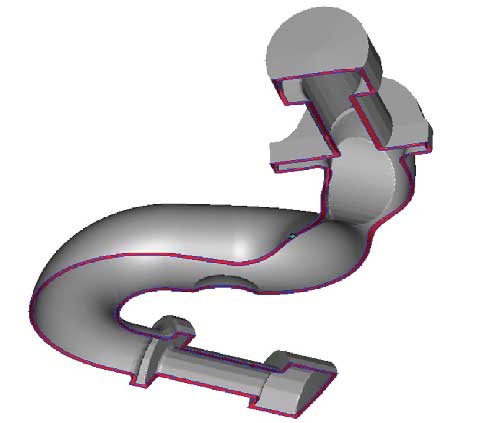
3D model of a pipe section, before file preparation.
Intended for use across an entire business organization, netfabb Studio comes in two levels, and is complemented by several premium tools for high-end applications. At the core is netfabb Studio Professional, which the company describes as an affordable way for multiple users to take advantage of a professional file-fixing tool. netfabb Studio Basic is free software that provides basic file repair capabilities (see more below) and lets non-experts in the business become literate in 3D printing. Both versions are available for Windows, Mac and Linux, and are supported in an unusual way with extensive Wikipedia entries. netfabb sees its software as a particularly good fit for companies whose AM builds do not require support generation (a feature that is not yet in Studio Professional).
netfabb Studio offers auto-repair, part editing, retriangulation, file reduction, Boolean operations and mesh refinement; a handy feature is that calculations can be paused, resumed and canceled. New features in v4.8 include polygon cut, advanced part selection, multiple part export and reduced memory consumption.
One US reseller, Will Shambley of Viridis3D, notes that the software is great if you need to add material, create an input channel for a casting application or pack dozens of files in one run.
netfabb Premium Tools include 3S (Selective Space Structures), Engines and Cloud Solutions. The 3S product lets users develop amazingly complex cell structures (or use a standard library) that are particularly helpful with metal work for both medical and industrial applications. netfabb Engines offers user-oriented interfaces for machine-specific build files, and Cloud Solutions offers a portfolio of server- and subscription-based functions that help users handle the business side of AM service.
A third, niche, player in the file-prep field is Within Lab, a UK company that recently started marketing four versions of its previously internal product Within Enhance. This software is focused on helping you create internal lattice structures and variable-density surface skins for optimized AM part production. Everything from surgical finger implants and hip replacement cups to engine blocks and heat exchangers are candidates for improvement with customized internal structures.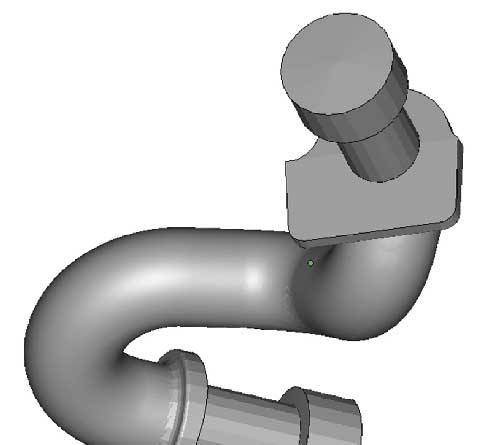
Pipe section file after smoothing operation with Materialise Magics16 software.Images courtesy Materialise.
At the core of the Within technology (no pun intended) is an optimization engine that uses such input parameters as desired weight, maximum displacement and stiffness, and creates a lattice structure that satisfies these requirements. Within Enhance is the top-of-the-line product; Within Lite, Variable and Analyse offer subsets of the full capabilities at different price points.
Geomagic, whose family of software creates digital models of scanned physical objects, offers some STL editing tools within its Geomagic Wrap software. This package creates and edits 3D polygon meshes, providing “cleaner” files for manipulation, but is not sold just for file repair.
Helping Consumers Print Their Models
netfabb Studio Basic, the free version of netfabb Studio, brings STL file preparation to the consumer and educational user. It provides basic display, mesh-edit, repair and part-placement capabilities in a package that uses just a few megabytes. A fun, free extra is the company’s netfabb Mobile software, a viewing app for the iPhone, iPod Touch and Android, for sharing STL files any time, anywhere.
In 2010, Shapeways, the online 3D printing company based in New York City, introduced its Mesh Medic Service powered by the netfabb Cloud Solutions installed on Shapeways servers. All files uploaded to Shapeways are examined and “health checked.” If needed, the netfabb Cloud Solutions software system enables Mesh Medic to repair holes, correct inverted normals, repair manifolds and generally fix the files for proper manufacturing. This process catches 95% of all problems, saving time for producing the more than 20,000 uploads received per month.
Sculpteo, another entry in the growing field of online 3D printing services, helps consumers submit standard design files, not STLs. Its website does a nice job offering tips on making the 3D model file as print-ready as possible. A tutorial also explains how to document colors and textures as an additional file. The suggestion is to use OBJ files for the model, its accompanying MLT file that contains color-indexing and texture data, and the texture file itself (JPG, PNG, GIF, etc.)
Recently partnered with Dassault Systèmes, Sculpteo has also begun offering a 3D Printing Cloud Engine that gives companies embeddable tools to develop and market their own 3D printed parts. Sculpteo will concentrate on providing support for all facets of such businesses, including an algorithm for design repairs.
Contributing Editor Pamela Waterman, DE’s simulation expert, is an electrical engineer and freelance technical writer based in Arizona. You can send her e-mail to [email protected].
MORE INFO
Subscribe to our FREE magazine, FREE email newsletters or both!
Latest News
About the Author
Pamela Waterman worked as Digital Engineering’s contributing editor for two decades. Contact her via .(JavaScript must be enabled to view this email address).
Follow DE





